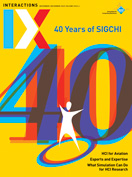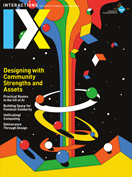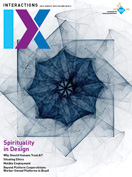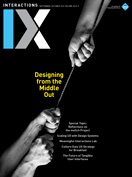Authors:
Dick van Dijk, Nick Dulake, Daniela Petrelli, Mark Marshall, Hub Kockelkorn, Elena Not, Dario Cavada, Stefano Maule, Anna Pisetti, Adriano Venturini
The Loupe resembles a magnifying glass. It is made of a round wooden frame that conceals a mobile phone. Visitors use the Loupe to discover more about objects on display. The Loupe shows an outline of a heritage object on the screen. The visitor then looks for that outline in their surroundings. When a real-life object and its outline match, the augmented reality app on the phone recognizes which content needs to be displayed. The visitor then tilts the Loupe to get more content or shakes it to move on to the next object. A new outline of an object is displayed as a suggestion for the visitor to continue.
Van der Vaart, M. and Damala, A. Through the Loupe: Visitor engagement with a primarily text-based handheld AR application. Proc. of Digital Heritage 2015. IEEE, 2015.
Damala, A., Hornecker, E., van der Vaart, M., van Dijk, D., and Ruthven, I. The Loupe: Tangible augmented reality for learning to look at Ancient Greek art. Mediterranean Archaeology and Archaeometry 16, 5 (2016), 73–85.
https://www.mesch-project.eu/mesch-prototype-the-loupe/
Dick van Dijk, Waag Technology & Society
[email protected]
 |
A visitor uses the Loupe to look for the matching shape on the ceiling. |
 |
When the user points the Loupe at the vase, the AR app detects the right shape and displays the graphics and text. |
 |
Tilting the Loupe displays the outline of the next object to seek. |
My Roman Pantheon is an interactive installation that invites visitors to take part in the Roman religion and its practices. At the entrance, visitors stop at the shrine of Juno, the queen of the Roman gods, to collect a votive lamp. Juno gives them three lights as offerings. Inside the museum, the visitor must carefully choose, among 13 deities, which three will receive their offerings. This will determine the visitor's future on Hadrian's Wall. On leaving, the visitor returns the votive lamp to Juno and receives an oracle with their future based on the choices they made.
Petrelli, D., Dulake, N., Marshall, M., Roberts, A., McIntosh, F., and Savage, J. Exploring the potential of the internet of things at a heritage site through co-design practice. Proc. 3rd Digital Heritage Conference 2018. IEEE Pub, 2018.
https://www.youtube.com/watch?v=68yRPP2PXfA&feature=youtu.be
Nick Dulake, Sheffield Hallam University
[email protected]
Daniela Petrelli, Sheffield Hallam University
[email protected]
Mark T. Marshall, Sheffield Hallam University
[email protected]
 |
Votive lamp disassembled, and a lamp next to oracles from the goddess Juno. |
 |
A visitor offering one of their three gifts of light to Cautes (on the top shelf). They now only have two offerings left—choose carefully! |
During WWII, a third of The Hague in the Netherlands was demolished by the German army to build a defensive system: the Atlantic Wall. The interactive installations in the exhibition give voice to the different, contrasting stories of the people involved in this process: German soldiers, Dutch civilians, and officers. Visitors activate these stories using "smart replicas." The interactions between visitors and the stories are recorded, resulting in a personalized postcard that visitors can take home. A unique code on the postcard gives access to a personalized website where more content can be explored and the visitor can upload personal and family memories.
Marshall, M.T., Dulake, N., Ciolfi, L., Duranti, D., Kockelkorn, H., and Petrelli, D. Using tangible smart replicas as controls for an interactive museum exhibition. Proc. of 10th Conference on Tangible, Embedded, and Embodied Interaction. ACM, New York, 2014, 159–167.
Petrelli, D., Marshall, M.T., O'Brien, S., McEntaggart, P., and Gwilt, I. Tangible data souvenirs as a bridge between a physical museum visit and online digital experience. Personal and Ubiquitous Computing 21, 2 (2017), 281–295; https://link.springer.com/article/10.1007/s00779-016-0993-x (open access)
https://www.mesch-project.eu/smart-object-enhanced-museum-exhibition-atlantik-wall-at-the-museon/
https://www.youtube.com/watch?v=sK3AdQU9kkc
Mark T. Marshall, Sheffield Hallam University
[email protected]
Nick Dulake, Sheffield Hallam University
[email protected]
Daniela Petrelli, Sheffield Hallam University
[email protected]
Hub Kockelkorn, MUSEON
[email protected]
 |
A visitor using a smart replica on an interactive station. |
 |
The personalized postcards. |
 4. Tangible Exploration of Historical Objects from WWI
4. Tangible Exploration of Historical Objects from WWI
This installation offers visitors the opportunity to touch and inspect original historical objects, an action generally forbidden in museums but that carries a high emotional engagement. When an object is placed in the center, the curator's voice invites the visitor to pick it up and touch it, observe it closely, and possibly pass it to a fellow visitor. Handling the object does not stop the narrative; the longer the object is handled, the more information is given, under the assumption that the visitor is interested. The narrative guides the discovery of details and the learning of aspects that normally go unnoticed.
Not, E., Cavada, D., Maule, S., Pisetti, A., and Venturini, A. Digital augmentation of historical objects through tangible interaction. ACM J. Comput. Cult. Herit. 12, 3 (2019), Article 18.
https://www.youtube.com/watch?v=auVwHdGQloc
Elena Not, Fondazione Bruno Kessler
[email protected]
Dario Cavada, ECTRL Solutions
[email protected]
Stefano Maule, ECTRL Solutions
[email protected]
Anna Pisetti, Museo Storico Italiano della Guerra
[email protected]
Adriano Venturini, ECTRL Solutions
[email protected]
 |
A graphical animation explains the tin is a military mess kit and shows a belt was used to secure it to the uniform. |
 |
Placing one of the objects on a central interactive point triggers an audiovisual description. Buttons allow you to change the language. |
©2019 ACM 1072-5520/19/09 $15.00
Permission to make digital or hard copies of all or part of this work for personal or classroom use is granted without fee provided that copies are not made or distributed for profit or commercial advantage and that copies bear this notice and the full citation on the first page. To copy otherwise, to republish, to post on servers or to redistribute to lists, requires prior specific permission and/or a fee.
The Digital Library is published by the Association for Computing Machinery. Copyright © 2019 ACM, Inc.






Post Comment
No Comments Found